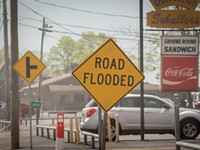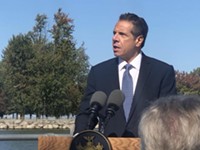Tuesday, June 17, 2014
Commission sends Lake Ontario levels plan to US, Canadian governments
Posted By Jeremy Moule on Tue, Jun 17, 2014 at 2:39 PM
The International Joint Commission has sent a report to the United States and Canadian governments recommending its Plan 2014 for managing Lake Ontario and St. Lawrence River water levels. The two governments have to approve the plan before it can go into effect, and the commission expects to receive responses from the US and Canada in coming months.
The commission is a US-Canadian group that handles issues involving water bodies shared between the countries. For almost 15 years, the commission has tried to develop and advance a modern plan to manage Lake Ontario and St. Lawrence River water levels. The levels are regulated via the Moses-Saunders hydropower dam on the St. Lawrence River, and the current approach uses a plan implemented in the early 1960's.
In a conference call this afternoon, US and Canadian commissioners said that Plan 2014 balances the interests of hydropower operators, the environment, commercial shipping, recreational boaters, and shoreline property owners. The previous plan didn't take the environment into consideration and, as a result, important coastal wetlands have been damaged.
"No regulatory plan can satisfy the needs of all the interests all of the time," said US Commissioner Dereth Glance said during the conference call.
The IJC released Plan 2014 last June; coastal wetland restoration is one of the plan's objectives. The plan's supporters say it would allow Lake Ontario water levels to more closely follow natural patterns: the water would be higher in the spring and lower in the winter, for example.
David Fay, senior engineering adviser on the commission's Canadian staff, says lakeshore property owners would see more periods of higher water — probably a few inches above the existing plan's levels — but also an increased number of low-water periods.
Plan 2014 also incorporates trigger points for management. When the water gets too high in the lake, more would be allowed through the dam and into the river. If it gets too low, some water would move from the river into the lake. But during this morning's media call, IJC representatives said that the lake's water levels are primarily influenced by natural events such as precipitation, ice melt, and evaporation.
But some south shore property owners, including many in the Rochester area, are unhappy with Plan 2014. They say the plan would result in damage to their property — and they won't be compensated. Glance and the commission's US chair, Lana Pollack, say Plan 2014 would increase shoreline maintenance costs by about 13 percent over the entire Lake Ontario-St. Lawrence River system, largely through repairing sea walls to prevent erosion. But the IJC doesn't have the authority to tell the governments to provide mitigation funding to south-shore residents, Pollack said.
The IJC did make some changes to the original Plan 2014, Glance said. Largely, the modifications are meant to provide additional flexibility for managing extreme low and high water levels, she said.
The commission is a US-Canadian group that handles issues involving water bodies shared between the countries. For almost 15 years, the commission has tried to develop and advance a modern plan to manage Lake Ontario and St. Lawrence River water levels. The levels are regulated via the Moses-Saunders hydropower dam on the St. Lawrence River, and the current approach uses a plan implemented in the early 1960's.
In a conference call this afternoon, US and Canadian commissioners said that Plan 2014 balances the interests of hydropower operators, the environment, commercial shipping, recreational boaters, and shoreline property owners. The previous plan didn't take the environment into consideration and, as a result, important coastal wetlands have been damaged.
"No regulatory plan can satisfy the needs of all the interests all of the time," said US Commissioner Dereth Glance said during the conference call.
The IJC released Plan 2014 last June; coastal wetland restoration is one of the plan's objectives. The plan's supporters say it would allow Lake Ontario water levels to more closely follow natural patterns: the water would be higher in the spring and lower in the winter, for example.
David Fay, senior engineering adviser on the commission's Canadian staff, says lakeshore property owners would see more periods of higher water — probably a few inches above the existing plan's levels — but also an increased number of low-water periods.
Plan 2014 also incorporates trigger points for management. When the water gets too high in the lake, more would be allowed through the dam and into the river. If it gets too low, some water would move from the river into the lake. But during this morning's media call, IJC representatives said that the lake's water levels are primarily influenced by natural events such as precipitation, ice melt, and evaporation.
But some south shore property owners, including many in the Rochester area, are unhappy with Plan 2014. They say the plan would result in damage to their property — and they won't be compensated. Glance and the commission's US chair, Lana Pollack, say Plan 2014 would increase shoreline maintenance costs by about 13 percent over the entire Lake Ontario-St. Lawrence River system, largely through repairing sea walls to prevent erosion. But the IJC doesn't have the authority to tell the governments to provide mitigation funding to south-shore residents, Pollack said.
The IJC did make some changes to the original Plan 2014, Glance said. Largely, the modifications are meant to provide additional flexibility for managing extreme low and high water levels, she said.
Speaking of...
-

Calendar preview: Looking up
Aug 19, 2020 -

As Lake Ontario rises, IJC looks to deviate from Plan 2014
Apr 6, 2020 -

New York to sue IJC over lake levels
Oct 10, 2019 - More »


